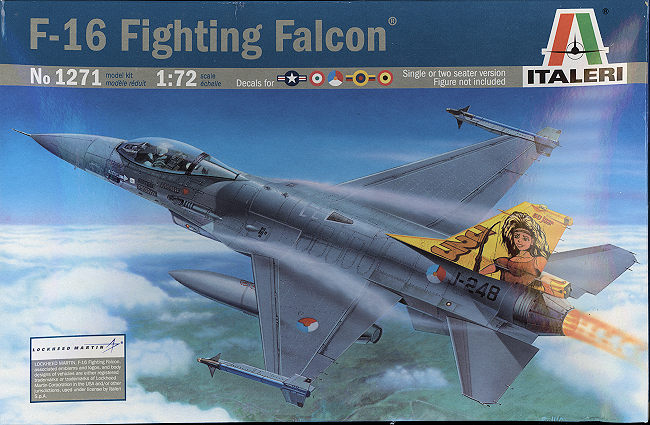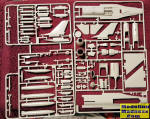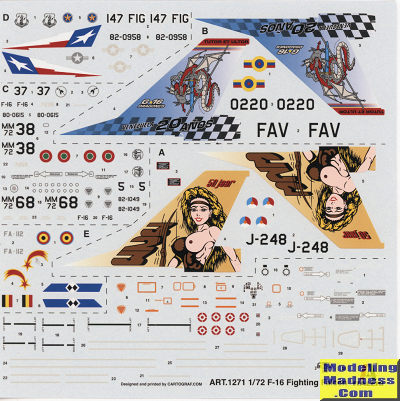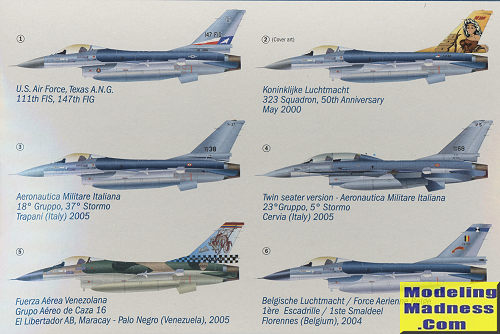
Italeri 1/72 F-16A/B Fighting Falcon
| KIT #: | 1271 |
| PRICE: | $15-20.00 on the street |
| DECALS: | Six options |
| REVIEWER: | Scott Van Aken |
| NOTES: | 2019 release |

| HISTORY |
The mainstay of many of the world's air forces is still the F-16 Fighting Falcon. Though the earlier A and B models are no longer being used by the USAF, production of this variant continued into the 90s for export. The F-16 combires a fairly decent fighter-bomber role in along with its air to air mission, and this ability to performe multiple missions with a single airframe, one that can be upgraded without too much effort is what has made the aircraft such a success. It is hard to see how the F-35 could be more effective as it is slower, less maneuverable, and does not quite have the same payload capabilities of the F-16. Probably one reason that the F-16 is still in production with the block 70/72 now being produced. While it is quite unlikely that the aircraft will surpass the production numbers of the F-4, more than 3,000 F-16s have been built.
| THE KIT |
 Italeri's
initial release of the F-16A/B was the older ESCI kit reboxed. This is still
a nice kit and offers the ability to build the very early F-16 before the
enlarged stabilizers. This kit was developed in the 1980s and was originally
kit #188 as the sprues still have this stamped on them. What is in the box
allows you to do not only the F-16A/B, but also the C/D version as that fin
is included. If you decide to build the C/D from this boxing, you'll be
limited to the early blocks as it does not include the wider wheels or
bulged main gear doors.
Italeri's
initial release of the F-16A/B was the older ESCI kit reboxed. This is still
a nice kit and offers the ability to build the very early F-16 before the
enlarged stabilizers. This kit was developed in the 1980s and was originally
kit #188 as the sprues still have this stamped on them. What is in the box
allows you to do not only the F-16A/B, but also the C/D version as that fin
is included. If you decide to build the C/D from this boxing, you'll be
limited to the early blocks as it does not include the wider wheels or
bulged main gear doors.
Pretty much every F-16 kit I've ever built has a horizontally split fuselage and a large upper fuselage insert to allow for either the single or two seat version to be built. This one is exactly like that. You get two separate cockpit tubs and they are minimally equipped with a single piece seat and an instrument panel. A decal is provided for decals. No real HOTAS, just a nub on the right to simulate the control stick. Once you decide on the number of seats, the interior(s) can be installed and the fuselage halves closed. The canopy is a single piece and you cannot pose it open as there are no hinges.
The intake provided is the small mouth and is three pieces with the nose gear well molded into the lower piece. The main gear bay is molded in with the lower fuselage half. Next, one attaches all the flight surfaces. There are two different fin inserts, one for the parabrake. Wings and stabs are a single piece so the holes for pylons are already drilled out. If doing the ADF version, you have fin bulges and an IFF antenna to install on the forward nose. You are also provided with an alternate open or closed burner can piece.
 Next
steps are installation of landing gear and doors. Again, pretty standard
stuff and somewhat simplified. Building up tanks and weapons is next. there
are cluster bombs provided and the pylons have the proper rack for these
items (two per side). There are also Sidewinders and AMRAAM missiles for the
various pylons.
Next
steps are installation of landing gear and doors. Again, pretty standard
stuff and somewhat simplified. Building up tanks and weapons is next. there
are cluster bombs provided and the pylons have the proper rack for these
items (two per side). There are also Sidewinders and AMRAAM missiles for the
various pylons.
Instructions are well done with Italeri Model Master and FS595 paint references. There are six markings options, all but one in the early three greys scheme. The box art plane is with 323 Squadron, Dutch Air Force in 2000, There is a 111 FIS, Texas ANG plane, two Italian aircraft, one a twin seat version, a standard Belgian AF plane, and finally a SEA camouflaged plane of the Venezuelan Air Force with a special fin marking. The decal sheet looks to be very nicely done and should provide no surprises.

| CONCLUSIONS |
August 2020
Copyright ModelingMadness.com. All rights reserved.
My thanks to me for picking this one up.
If you would like your product reviewed fairly and fairly quickly, please contact the editor or see other details in the Note to Contributors.
Back to the Main Page Back to the Previews Index Page Back to the Review Index Page